It’s nearly impossible for a consumer to know what quality of supplement they are getting. Just taking a peek behind this curtain (as we’ve tried to help people do) creates a bit of nervous tension. “Oh, great! More work for me to do before I buy something!” or “Everything is ruined, I just don’t care and will buy whatever’s cheapest!” are two very natural reactions to learning about the discrepancy between the products we want and the products that are available.
This article is the second in a series that will give you some tricks to quickly assess if the product or brand you’re considering is likely producing misleading, poor quality supplements.
Being able to judge the quality of supplements is an overwhelming task, so I’m giving you a framework to break it down into a step-wise, layered approach. Just like an onion.
Here are the 4 layers of the supplement quality onion I’m sauteing up for you:
- The claims a supplement or brand make
- Supplement Facts Panel
- Raw material selection
- The dirty secrets in the manufacturing
Today, we focus on the second layer of the supplement quality onion: the Supplement Facts Panel.
What is a Supplement Facts Panel?
Henceforth, we’ll call Supplement Facts Panel an SFP. When was the last time you used the word henceforth?
This is an SFP:
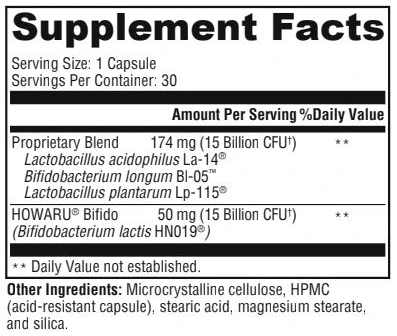
This is the thing we’ve all looked at then proceeded to twitch, gloss over, and eventually ignore because we’re not scientists! Or, maybe you are a scientist, but just not a supplement scientist. Either way, I’ll teach you to confidently navigate the SFP.
The FDA regulates dietary supplements. There are legal requirements for the labels, and one of those is to have a list of dietary supplement ingredients along with their quantities in a single defined place. The Supplement Facts Panel is that place. Think of it as the Nutrition Facts label on foods that you also ignore, except for supplements.
Directly below the SFP is the SFP’s buddy, the “Ingredient Statement” section, commonly called “Other Ingredients” on labels. This is where the list of all the other stuff like binders and fillers go.
There are rules about what order the ingredients go in, the “Daily Value” percentages (if an ingredient has one), and even down to the size, font, and the lines in and around the box. It’s all boring legal mumbo-jumbo and I know you don’t really want that much detail.
The important thing for you to know is that the Supplement Facts Panel is the source of truth for a supplement product. Everything that’s inside the bottle HAS to be listed here in some way. As we said in our first onion article, the label and marketing materials for a product can ramp up the rhetoric, speaking to lofty goals and aspirations for a product. The SFP reveals the truth; the SFP tells us what, specifically, is in the product and if there is enough to actually meet those hoity-toity claims.
The SFP is where the rubber meets the road for the manufacturer’s responsibilities. At the end of the day, a product must actually have the ingredients and the amounts listed on the SFP. If not, the product is one of the bad guys and falls into our “moldy cheeseburger” column highlighted from our 3 Types of Dietary Supplements article.
Important point: just because a product meets their label or Supplement Facts Panel does NOT mean it is good. A company whose product is “quality” from a manufacturing perspective is delivering what is promised. There’s a difference between meeting your responsibilities for delivering the product you promised and that product actually doing something for your customers. What was promised was a solid ending to Game of Thrones and Star Wars. We got one, but it doesn’t mean it was any good.
We use the SFP to uncover the product truth-to validate the claims made by the product and brand.
How We Use the Supplement Facts Panel to Evaluate Quality
I want to give you two scenarios of how you use the SFP to cut through the BS.
Our first product’s label is beautiful, has pictures of sheep jumping over the moon, and it is labeled
Dr. Neal’s Magic Sleep Support Formula #1The Supplement Facts Panel looks like this:
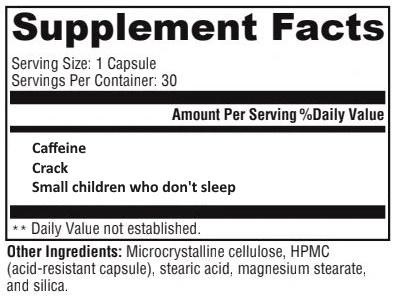
This product says it’s for sleep but it has literally all the things that keep you up at night. A dramatic example of a mismatch between the claim, yes, but the point stands. How about this?
Dr. Neal’s Magic Sleep Support Formula #2

Now we’re getting somewhere. This product is a “Sleep Support” formula and contains ingredients many people know to help with sleep.
There is a problem. The magnesium dose is really high (plus it’s not labeled correctly). The valerian and melatonin doses are extremely low. We don’t know if the valerian is the whole herb or an extract.
I don’t need you to know this off the top of your head. I need you to take a time out, though, and rethink how you approach supplements, using the data found in Supplement Facts Panels as a guide.
Before we decide if a supplement is right for us, we must answer three very simple questions:
- What’s my problem?
- What is an ingredient that might help?
- How much of that ingredient do I need?
We take that knowledge with us while we shop. We start with the fancy labels, looking for the claims that are in line with what we’re looking to do. We then must check the SFP to ensure the product has the right ingredients and the right dose.
“Wait, this isn’t 100% about the supplement panel, is it Neal?” You’re oh so right!
Navigating the SFP requires some buy-in from you.
Finding Quality Products Starts and Ends With You
My goal is to teach you that the system’s broken and give you tricks to outwit the trade. Underneath all of that, I make it my mission to explore the choices and behaviors we make that lead us to these wrong outcomes in the first place.
We’ve got to do some introspection to figure out what our hang ups or obstacles are…
Simply put, we don’t connect all the dots.
A blog may tell us turmeric is anti-inflammatory. A product may have turmeric on its label. Those things might even be true, although rare in the world of misinformation.
Yes, turmeric has anti-inflammatory properties, but does the product you’re buying have enough turmeric in it to anti-you-flammatories?
Taking it a step further, who cares about “anti-inflammatory” properties? Will the turmeric help with your knee pain?
We have to take things beyond what I refer to as the “academic discussion” around ingredients and keep connecting those dots to what matters: does the ingredient work in people and how much do I need to take for how long?
It doesn’t matter what the label claims are or if you know what a Supplement Facts Panel is if you don’t continue the thought process through to completion.
Just by doing this slight heavy lifting, you take your supplement savvy to a new level. I’m not asking for much, just connect the ingredient with a dose. Heck, I don’t even care if the dose and recommendations you find are all wrong, I just want you to tie the things together BEFORE you buy something.
How the Supplement Facts Panel Can Deceive You
You need some tools in that toolbox to help you understand your product better. What better way to teach you what to look for than using examples of all the tricks supplement companies use to deceive you on the Supplement Facts Panel.
Here are seven common tricks:
Proprietary Blend
To protect a company’s “intellectual” property, you are legally allowed to list your ingredients as a proprietary blend. Our Calcium Care that I formulated has that:

The problem is that many companies exploit this lack of transparency to give the perception that their product is this comprehensive formula. I’m not a jerk, so each of those ingredients are in enough concentration to actually do something.
With proprietary blends, companies are required to list in order of weight, so the heaviest or biggest content goes first.
In my Calcium Care example, we could have literally put 99% of the blend as that single ingredient, then split up the remaining 1% among the others. It’s a blend only in the basic definition of the word. We didn’t, but often this is the case.
Approach proprietary blends like you do loaning money to family: assume the worst. Assume your family won’t pay you back. On a proprietary blend, assume the first ingredient is 90+% of the mix. Does that change the product in any way?
An alternate view is to divide that number up equally. Here’s another blend taken from a patient consult just yesterday:

In this product, 2.5mg (roughly 3 bits of a paperclip that’s been sliced into 1000 bits) is divided by 4 different, really healthy sounding things means you’d get, on average 0.6mg per ingredient. Is that enough to do anything? If it were the coronavirus, then yes.
Healthy looking ingredients
This is very common in the shake mixes I discussed on a previous podcast episode. They list out all these very healthy-sounding items and it gets us pumped up.
Using our information from the proprietary blend, we can see that the actual amounts are very low. It should be clear to you that the company adds these types of lists to product to give consumers who don’t connect dosage to ingredients the perception of a healthy product.
In general, don’t look to supplements to be food replacements. More on this in a future article, but even the best processing methods create a product that is quite far removed from the real food.
If you ARE looking for whole food products, know you’ll be taking lots of pills with lots of milligrams of ingredients, not just the pixie-dusted products that bloat the marketplace.
Not the RIGHT ingredient
You do your research by reading a great article on buying the right magnesium supplement and go to the store to buy chelated magnesium. The problem is that we ignored the SFP that looks like this:

As you can see, the label may have said chelated magnesium, and yes, there is SOME in there, but the primary ingredient is magnesium oxide, a form that has less than 6% bioavailability.
Protect yourself here by keeping a laser focus on the ingredient you’re looking for and always double-check that SFP for the truth.
Not specific enough about the ingredient
We’ve talked about probiotics in our Gut Health webinar, in articles, and recently with probiotic expert Jessica ter Haar on the podcast.
A probiotic is a specific strain that at the right dose produces a specific health effect in humans.
The key word: specific strain.
Here’s more from that patient’s bottle yesterday:
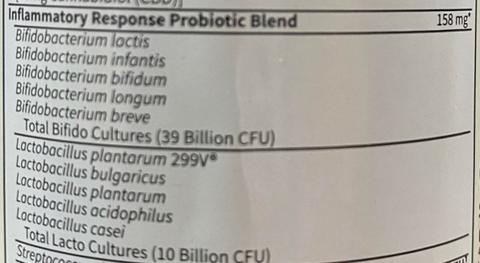
In the attached example, the SFP reveals the brand is not listing specific strains, meaning the assumption is that you’re getting NOT the right types of Lactobacillus acidophilus and friends.
Compare this to Probiotic Complete:

When you go to buy a car, you don’t just say “I want Ford.” You say, “Please don’t make me overpay for the 2019 Ford Taurus SE sedan.”
My fake sleep formula did the same thing. All that was listed was magnesium and valerian; we must know specifically what form of the ingredient is used.
They are specific, but that’s hiding the truth
Here are two examples of calcium products that often deceive people:
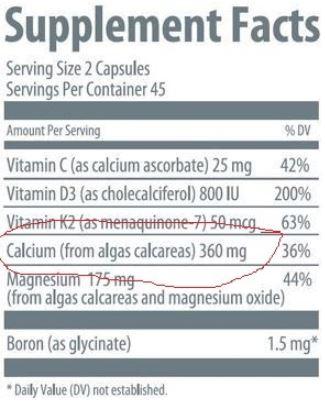
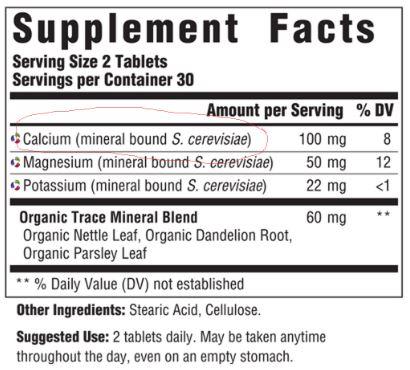
One is a “plant based” calcium from algae. The other is a “food” based calcium. They’re legally in the clear, but they’re hiding behind these names. They’re hiding the fact both are plain old calcium carbonate, which we said doesn’t work.
The marketing claims can sometimes bleed over into the SFP through these loopholes. Vigilance and diligence save the day.
Serving Size vs Dose
Omega-3 and M&M’s Tear and Share are guilty of these. What do you mean it’s 400 calories for the bag, it says 140 on the label! Oh, that’s per serving, and the bag is 4 servings…
Look at this Omega-3 label:

This product is only yielding 275mg per dose, but a consumer may believe they get 550mg because they’re not accounting for the serving size.
Always ensure the dose you need and the serving size are in sync.
Make Your Supplements Appropriate
After explaining how bad the natural products industry is (as I did recently on an excellent podcast called Kick Your Buts), my audience normally asks, “How do I know what’s good?”
My answer? You don’t. At least not quickly. That’s the point of these articles, to teach you the steps to become more aware of the problems and make better choices.
As we dive deeper into the supplement quality onion, we realize the level of effort for each of us increases.
No matter what, to not fall victim to the broken natural products industry that at best wastes our money and at worst could harm us, we have to roll up our sleeves.
I know you don’t have a lot of time. I know you don’t want to spend years researching all of this.
I also know you want to use something to help with your health goals. I’m here to tell you that you have to be slightly more active in that process.
A pharmacist’s main role is to ensure the medications someone takes is appropriate. This means it’s the right medicine at the right dose taken for the right amount of time.
As we peel back the layers, we get to the core of my mission: you must become your own advocate to ensure your supplements are appropriate.
“I heard it’s good” is no longer a good justification for you to blindly buy a product. Not if you’re going to hang around with this Big Mouth.
To judge your supplements’ appropriateness, you need to learn more about the ingredients you want to use, tying at least a correct dose to the ingredient.
From there, we work our quality onion, layer by layer to ensure the product we’re buying helps us meet our health goals.
We separate the layers of the onion to separate the rhetoric from reality.
If you need help with this schedule a 15-minute consult to review your health goals, supplements, and health choices.
Just trying to keep it real…

Neal Smoller, PharmD
Owner, Pharmacist, Big Mouth



